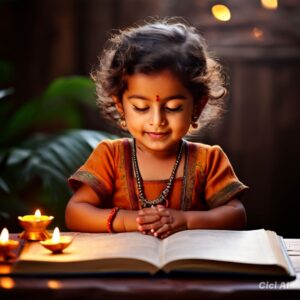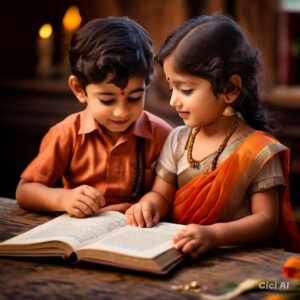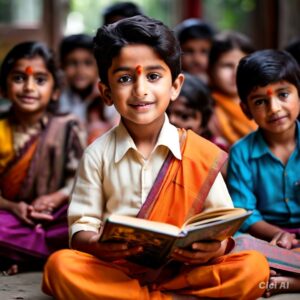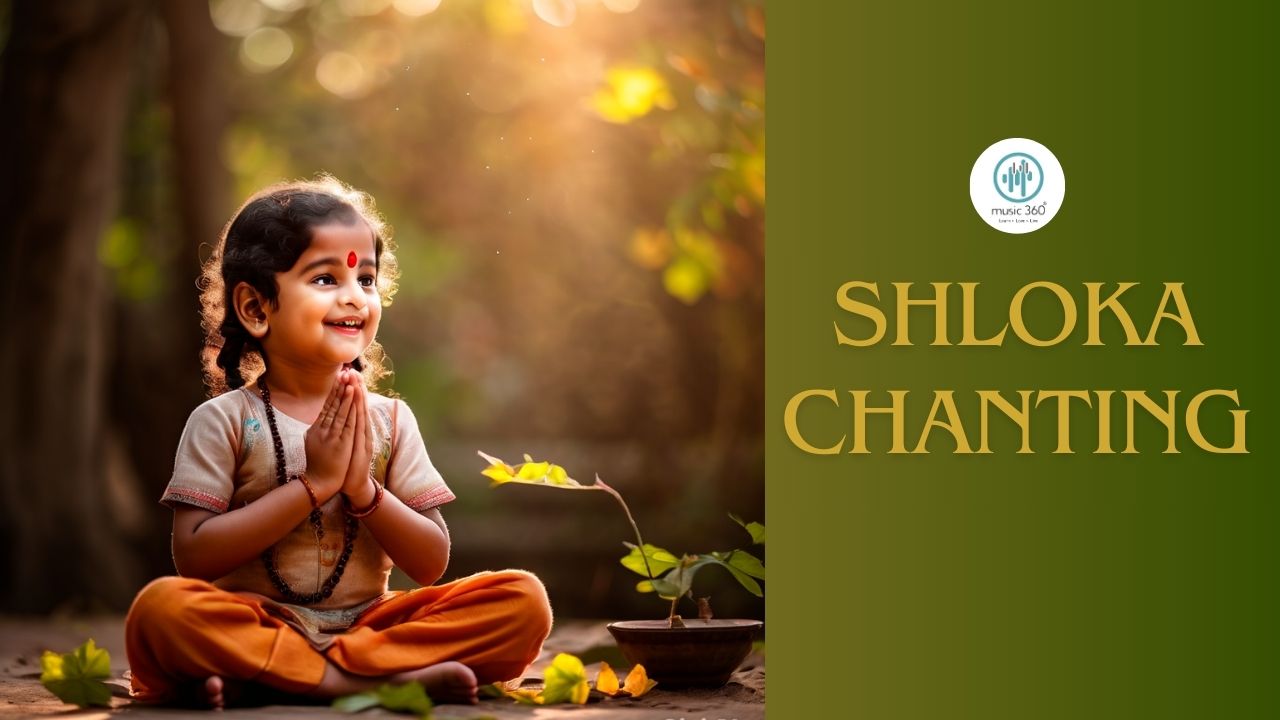Introduction to Shlokas

Shlokas are holy Sanskrit poetry that have profoundly intellectual overtones. Ancient Hindu texts like the Bhagavad Gita, Vedas, Upanishads, and Puranas all contain references to them. These lines, which are typically used as prayers or hymns to call forth blessings, knowledge, peace, and clarity, are composed with rhythmic sounds and spiritual meaning. Shloka chanting is generally used during rituals or prayer sessions, but it has also been scientifically connected to improved mental, emotional, and spiritual health.
Shloka chanting can be an effective strategy for promoting positive thinking, emotional equilibrium, language growth, and focus in kids. Kids can form these habits at a young age with the correct instruction, laying a solid basis for personal development and progress throughout their lives. This article investigates the mental health benefits, cognitive enhancements, and emotional resilience that shloka chanting can provide for young people.
How Shlokas Play a Role in Daily Life

Many people find it difficult to maintain mental health and stress management in the busyness of modern life. Shlokas provide emotional control and mental clarity, which serve as grounding techniques. Chanting produces a rhythmic vibration that calms the nervous system, encourages awareness, and helps us connect to higher moral principles. By learning shlokas, children are exposed to the ideas of patience, inner serenity, and spiritual grounding from a young age.
Shlokas are not just religious chants; they also promote discipline and optimistic attitude. Kids who start their days with mantras like the Gayatri Mantra or the Shanti Mantra see a shift in their mental patterns as well as an increase in optimism, focus, and thankfulness. Additionally, reciting these words fosters family bonding by fostering a peaceful and thoughtful environment at home.
How Shloka Chanting Affects Child Development

- Cognitive Growth
The systematic and rhythmic structure of shlokas enhances language development, memory, and cognitive function. Children’s speech, pattern recognition, and phonetic processing regions of the brain are activated when they recite shlokas. They are better able to concentrate on academic work and remember what they have learnt as a result.
How it works:
Children who learn intricate Sanskrit poetry and language by heart form stronger mental connections. This process of memorisation exercises the brain, enhancing neural connections and increasing comprehension of new ideas across a range of areas.
2. Mental Health and Emotional Control
A lot of shlokas, like the Shanti Mantra, concentrate on instilling mental tranquilly and tranquilly. Children who chant regularly are better able to cope with stress and anxiety, which are problems that younger people are facing in today’s fast-paced, digitally linked society.
Why it matters:
Chanting promotes deliberate breathing, which lowers stress chemicals like cortisol by activating the parasympathetic nerve system. Through this technique, kids can better control their emotions, maintaining emotional equilibrium even under trying circumstances.
3.Improved Concentration and Order
Reciting shlokas demands concentration and accuracy. Children gain patience and discipline as they learn how to chant correctly, using the right rhythm and intonation. This ability is applicable to the classroom, extracurricular activities, and interpersonal interactions, among other spheres of life.
Benefit:
By practicing shlokas, kids form the habit of persistently working towards their objectives, becoming more focused for extended periods of time, and encouraging perseverance.
4.Language and Speech Development
Sanskrit is renowned for its accuracy in phonetics. Children recite shlokas to enhance their articulation and pronunciation, which increases their self-assurance when speaking. Additionally, it improves their communication skills and fortifies their capacity to pick up new languages.
Example:
Children are forced to enunciate difficult syllables when reciting the Gayatri Mantra and other shlokas, which enhances their speech patterns and phonetic awareness.
5.Spiritual and Moral Development
Numerous shlokas place a strong emphasis on virtues like humility, honesty, gratitude, and compassion. Children internalise these principles through reciting such mantras, which aids in developing empathy for others and moulding their moral compass
Impact:
Humility, honesty, thankfulness, and compassion are among the qualities that are highly valued in many shlokas. By repeating these mantras, kids internalise these values, which helps shape their moral compass and foster empathy for others.
The Benefits of Shloka Chanting for Younger Kids

The early years are ideal for introducing children to mindful activities like shloka chanting because of how incredibly malleable their brains are at this age. Among the advantages are:
1.Stronger Memory and Learning Abilities
Chanting shlokas improves memory in both the short and long term due to its rhythmic and repeated character. They perform better in academic topics when they learn and remember shlokas, which enhances their memory retention skills.
2.Emotional Stability
Regularly reciting shlokas helps children relax by fostering a sense of emotional safety and stability. It is especially beneficial for kids who are hyperactive and have focus problems.
3.Boosted Immunity and Better Health
When deep breathing and chanting are coupled, the vagus nerve is stimulated, which strengthens the immune system and encourages relaxation. Children who maintain emotional equilibrium and composure are less likely to suffer from stress-related disorders.
4.Enhanced Self-Discipline and Responsibility
It takes time and persistent practice to learn shlokas by heart. This helps them develop time management and self-discipline skills, which improve their general demeanour and routine
Examples of Easy Shlokas for Children
1.Gayatri Mantra
“Om Bhur Bhuvah Svah,
Tat Savitur Varenyam,
Bhargo Devasya Dhimahi,
Dhiyo Yonah Prachodayat.”
- Benefit: increases mental clarity and attention.
2.Saraswati Vandana
“Saraswati Namastubhyam, Varade Kamarupini,
Vidyarambham Karishyami, Siddhir Bhavatu Me Sada.”
- Benefit: Increases motivation for learning and scholastic achievement.
3.Shanti Mantra
“Om Sahana Vavatu,
Sahanau Bhunaktu,
Sahaveeryam Karavavahai,
Tejasvinavadheetamastu Ma Vidvishavahai,
Om Shanti Shanti Shantih.”
- Benefit: Encourages tranquilly and psychological well
How to Introduce Shloka Chanting to Kids
- Start Small:
Longer shlokas should be introduced progressively after starting with shorter, simpler ones. - Create a Routine:
Make chanting a daily ritual, e.g., before going to bed or right after waking up. - Make it Fun:
Chanting can be entertaining when done in groups or with music or clapping patterns. - Lead by Example:
Kids are more prone to pick up habits if they witness their parents engaging in them on a daily basis.
Conclusion:
An age-old tradition known as shloka chanting has enormous advantages for children’s mental growth, emotional stability, and spiritual rootedness. It encourages discipline, concentration, good language use, and optimistic thinking. When children are exposed to shlokas at a young age, it not only helps them cope with stress and anxiety but also gives them vital life skills that support their overall growth.
Children can develop into well-rounded adults with a strong memory, emotional resilience, and a sense of purpose with regular practice. Children’s life can be transformed by introducing shloka chanting into everyday activities, whether at home or in school. It gives them the clarity, confidence, and composure to face obstacles head-on. When thoughtfully followed, this age-old custom can serve as a lifetime resource for development, serenity, and inner happiness.

